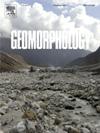Cosmogenic dating reveals the timing of glaciers collapse in the high Dolomites valleys (Northern Italy)
IF 3.1
2区 地球科学
Q2 GEOGRAPHY, PHYSICAL
引用次数: 0
Abstract
During the Last Glacial Maximum (LGM) the Italian Alps were extensively ice-covered with icefields feeding a network of interconnected valley glaciers and piedmont glaciers spilling into the foreland. The subsequent Lateglacial ice retreat occurred with different modes and timing across the region. This paper arises from the need for further investigation to better understand the glaciers' dynamics of the period and focuses on the glacial history of the Alta Badia valley (Eastern Dolomites, Italian Alps) as a key area for reconstructing the LGM glaciers' collapse and Lateglacial readvances within the region. We present a reconstruction of LGM and Lateglacial glaciers' evolution supported by cosmogenic 36Cl surface exposure data - obtained for the first time in the area - and geomorphological evidence. Our findings suggest that LGM ice retreat began before 17 ka BP. Within a general trend of ice decay, we identified the Gschnitz readvance from reconstructed glacier surfaces and Equilibrium Line Altitude (ELA) estimates, supported by moraine dating (15.8–15.4 ka BP) in the southeastern sector of the valley. Similarly, a Lateglacial readvance corresponding to the traditional Daun Readvance was recognized in the southwestern sector, based on exposure ages (14.4 and 13.3 ka BP) and calculated ELA. Evidence indicates that after the Daun phase, the valley was nearly deglaciated, retaining only small glacial remnants at higher elevations. This study enhances our understanding of LGM ice retreat and Lateglacial chronology, providing insights into the Alpine glacial history and establishing a foundation for estimating paleoclimatic conditions of the region.
宇宙起源测年揭示了高白云石山谷(意大利北部)冰川崩塌的时间
在末次盛冰期(Last Glacial Maximum, LGM)期间,意大利阿尔卑斯山被冰原广泛覆盖,形成了一个相互连接的山谷冰川和山前冰川网络,向前陆延伸。随后的冰川退缩在整个地区以不同的模式和时间发生。为了更好地了解这一时期的冰川动态,需要进一步研究,本文将重点放在Alta Badia山谷(东白云石,意大利阿尔卑斯山脉)的冰川历史上,作为重建该地区LGM冰川崩塌和冰川推进的关键区域。本文利用该地区首次获得的宇宙36Cl地表暴露数据和地貌证据,重建了LGM和冰川的演化过程。我们的研究结果表明,LGM冰川退缩开始于17 ka BP之前。在冰衰变的总体趋势中,我们通过重建的冰川表面和平衡线高度(ELA)估计确定了Gschnitz预估,并得到了山谷东南部冰碛测年(15.8-15.4 ka BP)的支持。同样,根据暴露年龄(14.4 ka BP和13.3 ka BP)和ELA计算,在西南段识别出与传统黎明超前相对应的冰川超前。有证据表明,在黎明期之后,山谷几乎冰川消融,只在高海拔地区保留了小的冰川遗迹。该研究增强了我们对LGM冰川退缩和冰川年代学的认识,为高寒冰川历史提供了新的认识,并为估计该地区的古气候条件奠定了基础。
本文章由计算机程序翻译,如有差异,请以英文原文为准。
求助全文
约1分钟内获得全文
求助全文
来源期刊

Geomorphology
地学-地球科学综合
CiteScore
8.00
自引率
10.30%
发文量
309
审稿时长
3.4 months
期刊介绍:
Our journal''s scope includes geomorphic themes of: tectonics and regional structure; glacial processes and landforms; fluvial sequences, Quaternary environmental change and dating; fluvial processes and landforms; mass movement, slopes and periglacial processes; hillslopes and soil erosion; weathering, karst and soils; aeolian processes and landforms, coastal dunes and arid environments; coastal and marine processes, estuaries and lakes; modelling, theoretical and quantitative geomorphology; DEM, GIS and remote sensing methods and applications; hazards, applied and planetary geomorphology; and volcanics.
 求助内容:
求助内容: 应助结果提醒方式:
应助结果提醒方式:


